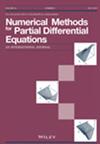用人工边界法数值求解自由场中的对流波方程
IF 1.7
3区 数学
Q1 MATHEMATICS, APPLIED
引用次数: 0
摘要
在本文中,我们提出了两种程序,重点计算自由场中均匀背景流的时变对流波方程。这两个程序都基于 Du 等人(SIAM J. Sci. Comput.40 (2018), A1430-A1445.)的框架,构建了Dirichlet-to-Dirichlet(DtD)型离散吸收边界条件(ABC)。第一个过程致力于通过直接应用对流波方程有限差分离散化框架,将无限问题还原为有限问题。然而,对流项的存在使得稳定性分析难以实现,这促使我们开发第二种程序。首先,利用普朗特-格劳尔特-洛伦茨变换将对流波方程转换为标准波方程。然后,我们利用上述框架得到 DtD 型 ABC,并在此基础上推导出等效的 Dirichlet 到 Neumann 型 ABC,从而使经典能量法易于得到稳定性和收敛性分析。通过数值实验研究了这两种程序的有效性和比较。本文章由计算机程序翻译,如有差异,请以英文原文为准。
Numerical solution of convected wave equation in free field using artificial boundary method
In this article, we propose two procedures focusing on the computation of the time‐dependent convected wave equation in a free field with a uniform background flow. Both procedures are based on a framework, expended from Du et al. (SIAM J. Sci. Comput. 40 (2018), A1430–A1445.), of constructing the Dirichlet‐to‐Dirichlet (DtD)‐type discrete absorbing boundary conditions (ABCs). The first procedure is dedicated to reducing the infinite problem into a finite problem by a direct application of the framework on the finite difference discretization of the convected wave equation. However, the presence of convection terms makes the stability analysis hard to implement, which motivates us to develop the second procedure. First, the convected wave equation is transformed into a standard wave equation by using the Prandtl‐Glauert‐Lorentz transformation. After that, we obtain the DtD‐type ABC by using the above framework, and on this basis, derive an equivalent Dirichlet‐to‐Neumann‐type ABCs, which makes stability and convergence analysis easy to be obtained by the classical energy method. The effectiveness and comparison of these two procedures are investigated through numerical experiments.
求助全文
通过发布文献求助,成功后即可免费获取论文全文。
去求助
来源期刊
CiteScore
7.20
自引率
2.60%
发文量
81
审稿时长
9 months
期刊介绍:
An international journal that aims to cover research into the development and analysis of new methods for the numerical solution of partial differential equations, it is intended that it be readily readable by and directed to a broad spectrum of researchers into numerical methods for partial differential equations throughout science and engineering. The numerical methods and techniques themselves are emphasized rather than the specific applications. The Journal seeks to be interdisciplinary, while retaining the common thread of applied numerical analysis.

 求助内容:
求助内容: 应助结果提醒方式:
应助结果提醒方式:


